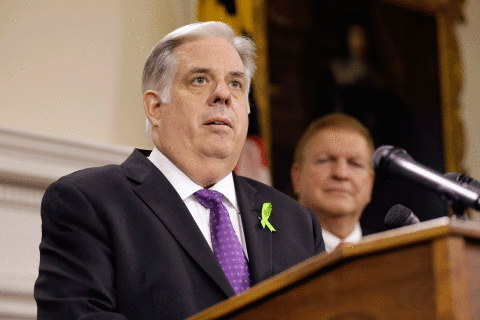By JOSH MAGNESS and JESSICA CAMPISI
COLLEGE PARK – Throughout the 2016 primaries, national figures like presumptive Republican nominee Donald Trump and Vermont Sen. Bernie Sanders enthralled primary voters with hardline ideological positions.
But Maryland Gov. Larry Hogan took another approach — a form of moderate populism with bipartisan appeal.
In order to gain support in a strongly blue state — the second-most Democratic state in the nation, according to a 2015 Gallup poll — Republican Hogan has centered his efforts on fiscal policies while staying away from social issues.
With Trump poised to accept the Republican Party’s nomination for president this week, he could take a page from Hogan’s play book if he wants to gain some cross-party appeal in the general election race. Or it could be a party lesson for 2020, should he lose to presumptive Democratic nominee Hillary Clinton in November.
Todd Eberly, an associate professor of political science and public policy at St. Mary’s College, said Hogan is potentially providing a winning model for the GOP in the 2020 general election if Trump — who has a 60 percent unfavorable rating according to the Real Clear Politics aggregate of polls — loses.
Like Trump, Hogan has experience as a businessman. But Hogan, Eberly said, is also more “mild-mannered” and has shown he can win — and maintain popularity in — blue states.
“If 2016 goes poorly, (Republicans) will be looking around come 2020 for someone to right the ship and correct mistakes made in nominating someone like Trump,” he said. “In some respects, in many respects, he’s sort of the anti-Trump.”
Hogan has continued to focus on lowering taxes and fees for Marylanders. In September 2015, Hogan announced plans to reduce fees paid by state taxpayers by around $51 million over a five-year period through measures such as a reduction to $1 for homeless identification cards and elimination of the $1.50 monthly EZ-pass fees.
He also ordered the reduction of 100 fees across the state government and another 115 related to animal health diagnostics at the Department of Agriculture.
And those policies worked in his favor. In April 2016, as the Maryland General Assembly legislative session reached its conclusion, Hogan’s approval rating scaled to 66 percent, making him the most popular governor since at least 1998, according to a Washington Post and University of Maryland poll.
On May 12, he announced an additional $60 million in fee cuts for businesses and taxpayers. He’s also vowed to lower state borrowing and spending, proposing a $17.1 billion operating budget for fiscal year 2017 that would leave a surplus of nearly $450 million.
“This state is open to the middle,” said Joe Cluster, executive director of the Maryland Republican Party. “He’s not a governor for just Republicans. He’s a governor for all Marylanders.”
Hogan on social issues
Dan Nataf, the director of the Center for the Study of Local Issues at Anne Arundel Community College in Arnold, said Hogan has maintained his popularity in the state because he avoided those social issues that a majority of Marylanders favor.
In 2012, this state became the first to affirm the right of same-sex couples to wed through a popular vote when residents cast their ballots 52.4 to 47.6 percent in favor of Question 6. The referendum asked voters to approve or reject the Civil Marriage Protection Act, which legalized gay marriage.
A 2014 Pew Research Center Poll found that nearly half of Republicans and Republican-leaning voters within the state — 45 percent — think abortion should be legal in all or most cases. Seventy-four percent of Democratic or Democratic-leaning voters said the same.
In a state where Democrats outnumber Republicans by a roughly 2-1 margin, that indicates a solid majority of state voters are in favor of abortion rights.
But if Hogan were to live in a more conservative state, Nataf said, he would be forced to take a more partisan position, likely inciting controversy that would draw attention away from fiscal position
“In some states, like in the South and Midwest, the Hogan model wouldn’t work because there is a larger Christian Fundamentalist population that would force him to be more conservative on cultural issues,” Nataf said. “The model — avoid social stuff and focus on moderate fiscal issues — shows it can be used in a blue state.”
Louis Pope, the national committeeman for the Maryland Republican Party, said other Republican governors in usually blue states have followed a similar path to success as Hogan.
Pope points to Massachusetts Gov. Charlie Baker and Illinois Gov. Bruce Rauner, both businessman and Republicans, as parallels to Hogan.
During their campaigns, all three said they would not delve into social issues and instead concentrate on conservative fiscal positions like tax reduction, Pope said.
Keeping their promises, he continued, has endeared them to their constituents.
“They all won in upsets,” Pope said. “It’s a winning strategy, but it’s not a unique strategy.”
Capital News Service is a student-staffed news wire and broadcast news service operated by the University of Maryland’s Merrill College of Journalism. © 2016 Capital News Service. All Rights Reserved.





